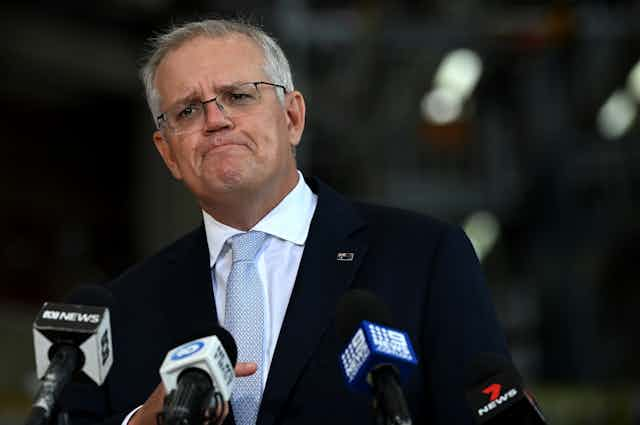The leaking and use of text messages purportedly between former New South Wales Premier Gladys Berejiklian and a member of federal cabinet, in which Prime Minister Scott Morrison is described as “a horrible, horrible man”, “a complete psycho” and “a fraud” raise several serious ethical issues.
Peter van Onselen, the political editor of Network Ten, was the recipient of the leak, and dramatically made its contents public by reading them out in the form of a question to Morrison at the National Press Club on February 1.
He did not disclose the source of the leak, from which it can be inferred it was made in circumstances of confidentiality – in other words, on condition of anonymity.
This brings us to the first ethical issue. A person who provides information to a journalist on condition of confidentiality is entitled to expect that confidentiality will be honoured by the journalist.
This obligation is enshrined in Australia’s national journalists’ code of ethics, that of the Media, Entertainment and Arts Alliance.
It is reinforced by the existence in all states except Queensland of what are called “shield laws”, which allow journalists to apply for a privilege against disclosing the identity of confidential sources in legal proceedings. Journalists in Australia have gone to jail rather than betray their source in court.
However, the same code requires that journalists should not enter into an obligation of confidentiality without first considering the source’s motives.
Read more: View from The Hill: Morrison a 'psycho' – now who would have said that?
This brings us to the second ethical question: did van Onselen try to establish what the motive of this leaker was? If not, why not?
For instance, why are these texts only coming to light now – two years after they were reportedly sent? It strongly suggests they have been stored up as ammunition for a strike against Morrison at a time when someone or some faction in the Liberal Party thinks it will do the most damage. And who is likely to benefit?
Moreover, was it part of the deal with the source that the material would be published in the way it was: as a question to Morrison in front of the cameras and a roomful of journalists at the National Press Club?
He owes the public an explanation about this, without giving away the identity of the source.
The third ethical issue concerns what steps, if any, van Onselen took to verify the provenance of the texts before making them public. This too is a matter on which he owes the public an explanation.
In the fallout from his disclosures, Berejiklian has said she does not remember sending such a text. But this falls far short of denying that she did.
Had van Onselen at least obtained that much from Berejiklian, he could have included it in his question to the prime minister.
He would have added to the strength of his leak by demonstrating he had taken some steps towards verification.
It also would have equipped van Onselen or any of the other journalists present to tell Morrison that Berejiklian had not denied sending the text, so what did he have to say about that?
This would have undercut Morrison’s strategy of sweeping these epithets aside as mere anonymous sledging.

The fourth ethical issue concerns the extent to which van Onselen informed his editorial superiors at Network Ten about the leak, the circumstances in which he had obtained it and how he proposed to use it.
When journalists who work for a media organisation enter into an obligation of confidentiality, they bind not just themselves but their editor and their organisation.
Whether an editor will ask for the source’s identity is a matter of policy which varies from one organisation to another. Most generally will not, especially in a case like this where the journalist is a senior member of staff.
However, the editor is entitled to ask what steps the journalist has taken to establish motive, what the journalist’s assessment of the motive is, and what steps have been taken to verify the contents.
The objectives here are to be as sure as reasonably possible that the material is genuine, and to be as transparent with the public as possible without revealing the source.
This is at least a partial antidote to the anonymity problem. Morrison has understandably seized on this, using the anonymous nature of the leak to try to detract from its damaging contents.
There is absolutely no question that the contents of the leak are of very significant public interest. Van Onselen was entirely justified in publishing them on public-interest grounds.
One final ethical question remains: has van Onselen been used as a catspaw by Morrison’s factional enemies and even if he has, does it matter? After all, many leaks of high public interest come from people with axes to grind.
Only the people involved will know whether he has been, and it does matter because journalists should take care not to be used as a catspaw.
That is why the questions of motive, verification and timing are so important in cases like this. It is a further reason why van Onselen and Network Ten owe the public as transparent an explanation for their conduct as possible without betraying the source.

